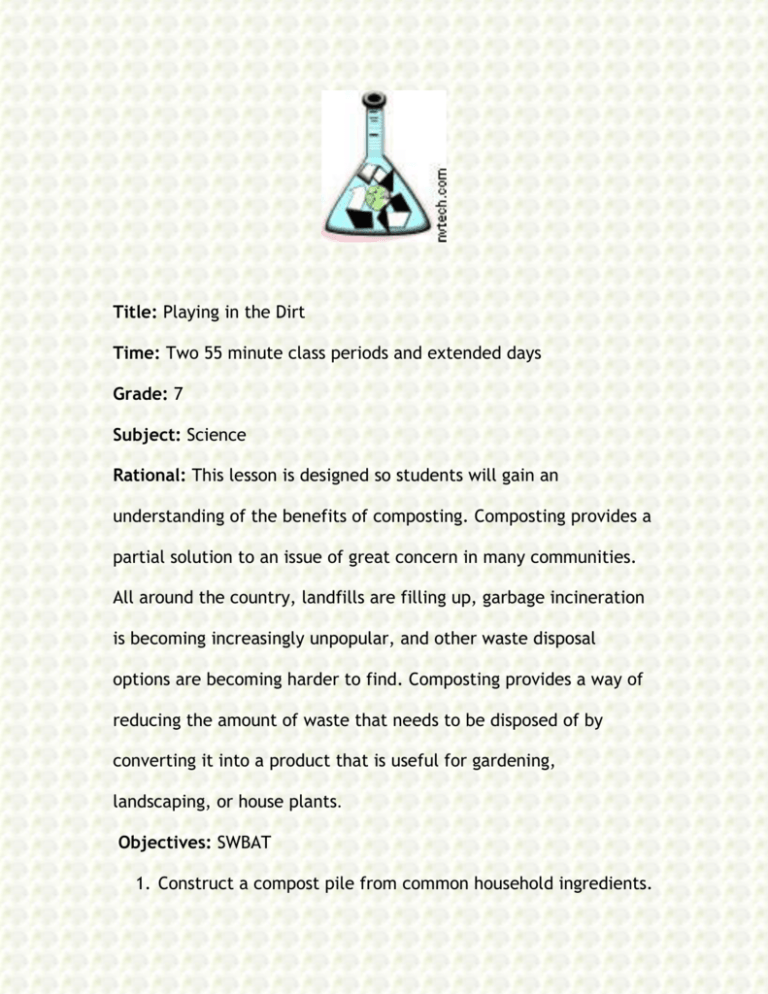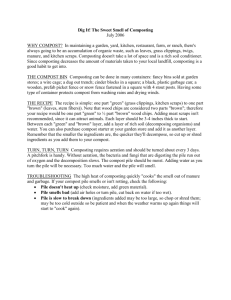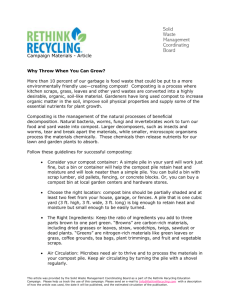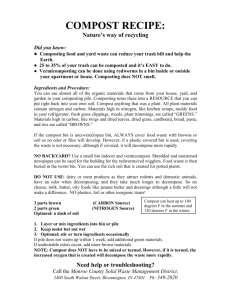Title: Making a Cake the Recycled Way
advertisement

Title: Playing in the Dirt Time: Two 55 minute class periods and extended days Grade: 7 Subject: Science Rational: This lesson is designed so students will gain an understanding of the benefits of composting. Composting provides a partial solution to an issue of great concern in many communities. All around the country, landfills are filling up, garbage incineration is becoming increasingly unpopular, and other waste disposal options are becoming harder to find. Composting provides a way of reducing the amount of waste that needs to be disposed of by converting it into a product that is useful for gardening, landscaping, or house plants. Objectives: SWBAT 1. Construct a compost pile from common household ingredients. 2. Discuss the methods used in composting. QCCs: Topic: Scientific Inquiry Process Standard: # 1. Uses process skills of observing, classifying, communicating, measuring, predicting, inferring, identifying, and manipulating variables. Also uses recording, analyzing, and operationally defining, formulating models, experimenting, constructing hypotheses and drawing conclusions. Materials: Kitchen Compost vegetable peels and seeds fruit peels and seeds coffee grounds egg shells nut shells any other vegetable or fruit scraps water Note: Do not add meat scraps, bones, dairy products, oil, or fat. They may attract pest animals. Yard or Garden Compost hay or straw grass clippings leaves ashes sawdust wood chips weeds and other garden waste manure - shredded paper soil Classroom Materials pencils paper computer with internet access video graphics projector compost bin – made from chicken wire or wood Anticipatory Set: For a bell ringer, I would ask the students to take a piece of notebook paper and tear it into strips. Next I would have a couple of students go to the garbage can and retrieve all of the paper that has been thrown away and place it in a pile on the floor in the front of the room. Next, I would ask the students how we could use this pile of paper to save money and benefit the environment. Procedure: 1. The teacher will visit the following website, http://www.cfe.cornell.edu/compost/why.html and explore the site and different links with the students. 2. The teacher will encourage the students to discuss the process of composting including the reasons, benefits, maintenance, cost, and time involved. 3. The teacher will visit the following website, http://www.cfe.cornell.edu/compost/quiz1.html and have the class verbally answer each question. 4. On the second day, the teacher will take the students to the selected spot for the compost pile and begin the process of making the pile. 5. The teacher will have the students spread soil or "already done" compost over the compost pile. This layer contains the microorganisms and soil animals that do the work of making the compost. It also helps keep the surface moist. The pile should be about 4 cubic feet in size. 6. Adjust the moisture to the compost pile. Add dry straw or sawdust to soggy materials, or add water to a pile that is too dry. The materials should be damp to the touch, but not so wet that drops come out when squeezed. 7. Allow the pile to "bake". It should heat up quickly and reach the desired temperature (90 to 140 degree F, or 32 to 60 degree F) in four to five days. 8. "Stir" the compost as it bakes by turning it with a pitch fork or shovel to speed up the baking time. 9. The pile will settle down from its original height. This is a good sign that the compost is baking properly. 10. If the compost pile is mixed or turned every week, it should be "done", or ready to use, in one to two months. If it is not turned, the compost should be ready in about six to twelve months. 11. The compost should look like dark crumbly soil mixed with small pieces of organic material. It should have a sweet, earthly smell. 12. Feed compost to hungry plants by mixing it with the soil. Evaluation: The teacher will visual observe and monitor students participating in the activity. Participation will also be noted through the student led discussions on composting. This project is ongoing and the teacher will ask for volunteers to monitor the compost pile for the remainder of the year. The students will receive a class participation grade based on the following rubric. Compost Pile Teacher name: Mr. Bradshaw Student Name ___________________ CATEGORY Excellent Good Satisfactory Needs Improvement Participation Student showed great enthusiasm and focused on the task. Was helpful to others, if asked. Student showed some enthusiasm and focused on the task. Was helpful to others, if asked. Student did work, but lost focus or became frustrated. Did not distract others. Student often lost focus or became frustrated and distracted others. Playing in the Dirt was adapted from a lesson plan idea found at http://aggiehorticulture.tamu.edu/extension/compostfacility/les12.htm.








